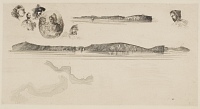Etchings Institutions search term: heinemann
Sketches on the Coast Survey Plate | ||
| Number: | 1 | |
| Date: | 1854 | |
| Medium: | etching | |
| Size: | 149 x 253 mm | |
| Signed: | 'J.W.' at upper left | |
| Inscribed: | no | |
| Set/Publication: | no | |
| No. of States: | 1 | |
| Known impressions: | 28 | |
| Catalogues: | K.1; M.1; T.- | |
| Impressions taken from this plate (28) | ||
TECHNIQUE
John Ross Key (1837-1920), gave an account of Whistler's introduction to the etching process at the U.S. Coast Survey office:
'Mr McCoy, one of the best engravers in the office, a kindly, genial Irishman ... went over the whole process with us - how to prepare the copper plate, how to put on the ground, and how to smoke dark so that the lines made by the point could be plainly seen.
... For the first time since his entrance into the office Whistler was intensely interested ... He listened attentively to McCoy's somewhat wordy explanations, asked a few questions, and squinted inquisitively through his half-closed eyes at the samples of work placed before him. Having been provided with a copper plate ... and an etching-point, he started off to make his first experiment as an etcher. I watched him with unabated interest from the moment he began his work until he completed it, which took a day or two.
... At intervals, while doing the topographical view, he paused to sketch on the upper part of the plate ... After he had finished etching, I watched him put the wax preparation around the plate, making a sort of Reservoir to hold the acid, as McCoy had instructed.
... Then he poured the acid on the plate ... we watched it bite and bubble about the line, as with a brush he carefully wiped the line to prevent the refuse accumulating and biting unequally. When ... the plate was bitten sufficiently, and the acid was poured off, and the wax removed, we went again to McCoy to ask him how to get the ground off. ... Finally we went to the basement, where the printer washed the plate, and an impression was then taken of Whistler's first etching.' 16
16: Key 1908 .
The Pennells commented:
'The drawing is schoolboy-like, though it shows certain observation, but the biting is remarkable. The little figures are bitten as well and in the same way as in La Vieille aux Loques, etched three or four years afterwards: to look at them is to know that Whistler was a consummate etcher technically before he left the Coast Survey. There is no advance in the biting of the French series. So astonishing is this mastery that, if the technique in some of the French plates were not so similar, one would be tempted to doubt whether Whistler really etched those little figures in Washington, especially
as the plate is unsigned.' 17
17: Pennell 1908 , I, pp. 44-5; in fact the plate is signed.
PRINTING
John Ross Key (1837-1920) told Freer in 1896 that he had some impressions printed:
'I have never had more than 25 or 30 taken and the plate has never been out of my possession. I sent a few copies some years ago to S. P. Avery - N. Y. (3 or 4) who was much interested in the matter'. 18
18: Key to Freer, [15 February 1896] , GUW #11723.
Samuel Putnam Avery (1822-1904), mentioned by Key as having looked at some of his prints, retained one impression ( ). John Ross Key's estimate of '25 or 30' prints might be accurate. However, a few more impressions appear to have been printed, probably when the plate was owned by William Keeney Bixby (1857-1931), between 1905 and 1913 (
). John Ross Key's estimate of '25 or 30' prints might be accurate. However, a few more impressions appear to have been printed, probably when the plate was owned by William Keeney Bixby (1857-1931), between 1905 and 1913 ( ). 19
). 19
 ). John Ross Key's estimate of '25 or 30' prints might be accurate. However, a few more impressions appear to have been printed, probably when the plate was owned by William Keeney Bixby (1857-1931), between 1905 and 1913 (
). John Ross Key's estimate of '25 or 30' prints might be accurate. However, a few more impressions appear to have been printed, probably when the plate was owned by William Keeney Bixby (1857-1931), between 1905 and 1913 ( ). 19
). 19
19: Museum records, St Louis Art Museum.
